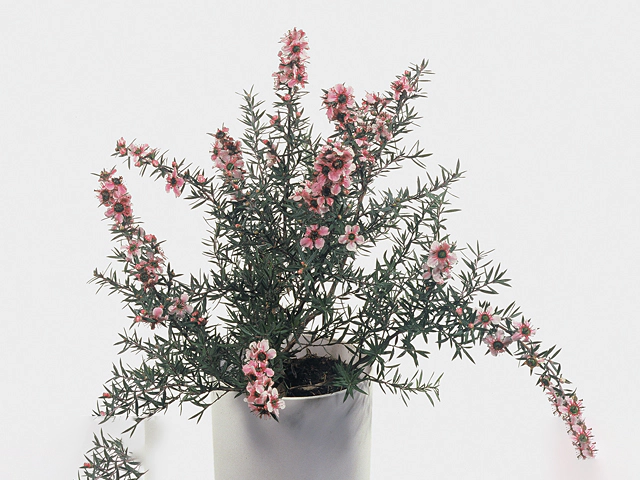Leptospermum scoparium

| Flower scent | Unscented |
| Leaf type | Foliage leaf |
| Winter hardness | Limited (USDA-zone 8) |
| Flower color | Pink-medium red pink-052B; White-white-155B |
| Leaf, scent | Pleasantly scented |
| Plant height | 20 - 30 cm |
| Inflorescence | Few-flowered |
| Structure (tissues) | Woody |
| Leaf size | 1 - 2 cm |
| Leaf division | Simple |
| Plant, growth type | Erect |
| Flower color distribution | Bicolored; Bicolored |
| Toxicity (if consumed) | Not or barely |
The Tea Tree, also known as Leptospermum scoparium, is a small shrub native to New Zealand. It is a versatile plant that is valued for its medicinal properties, as well as its ornamental qualities. The Tea Tree belongs to the family Myrtaceae and is commonly referred to by its other names, Manuka and Ti-tree.
One notable characteristic of the Tea Tree is its unscented flowers. The flowers come in various colors, ranging from pink-medium red to white. They are few-flowered and have a bicolored distribution of colors. The plant itself is relatively small, reaching a height of 20-30 cm.
The leaves of the Tea Tree are pleasantly scented and have a foliage leaf structure. They are typically 1-2 cm in size and have a simple division. The plant has a woody structure, which adds to its durability and ability to withstand harsh weather conditions.
In terms of growing conditions, the Tea Tree prefers full sun exposure and low water requirements. It thrives in acidic soil with a pH level that is suitable for its growth. The plant is known to be winter-hardy up to USDA Zone 8, meaning it can tolerate cold temperatures to some extent.
One of the unique qualities of the Tea Tree is its medicinal properties. The plant has long been used by indigenous cultures as a natural remedy for various ailments. The leaves and oil extracted from the Tea Tree possess antimicrobial and anti-inflammatory properties, making them effective in treating skin conditions such as acne, wounds, and fungal infections.
Apart from its medicinal uses, the Tea Tree is also valued for its ornamental qualities. Its compact size and attractive flowers make it a popular choice for gardens and landscaping. It can be grown in pots or planted directly in the ground, adding beauty and elegance to any outdoor space.
It is important to note that while the Tea Tree has numerous beneficial qualities, it is not suitable for consumption. The plant is not or barely toxic if consumed, meaning it should be kept away from children and pets.
In conclusion, the Tea Tree, also known as Leptospermum scoparium, is a versatile plant that offers both medicinal and ornamental benefits. Its unscented flowers, pleasantly scented leaves, and compact size make it a desirable addition to any garden. With its winter-hardiness and low maintenance requirements, it is an ideal plant for those looking to add beauty and functionality to their outdoor spaces. However, it is advised to handle the Tea Tree with care and keep it out of reach from children and pets due to its potential toxicity if consumed.
Market availability index by month:
| Jan. | Feb. | Mar. | Apr. | May | Jun. | Jul. | Aug. | Sep. | Oct. | Nov. | Dec. |
|---|---|---|---|---|---|---|---|---|---|---|---|
| 2 | 4 | 3 | 4 | - | - | - | - | - | - | - | - |